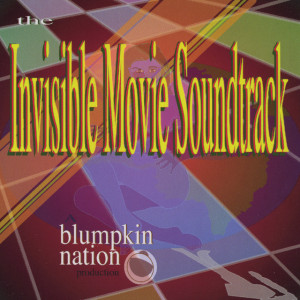 Craig Clarke wrote this review.
Craig Clarke wrote this review.
With a title like The Invisible Movie Soundtrack — to which there is no accompanying film — it is difficult to listen to this album without wondering just what kind of cinematic experience this would accompany. In the end, it’s probably just a creative marketing ploy — a way to put out a collection of songs by different artists without calling it an “anthology.” Not that I object. I’m a proponent of creativity in all its forms, and if it makes me use my mind in a way to which I’m not accustomed, then all the better.
The CD takes the form of an eclectic mix of songs of various styles, beginning with “northentro,” a short electronic instrumental which would be well-used under a couple of studio splashes.
Beginning with plaintive banjo plucks, “She Sings to Me” would be the hit single played along with a set of animated opening credits. Reminiscent of the harmony-laden pop of the Beatles and the Archies, this tasty pop confection could easily take off up the charts given the right promotion.
The fact that it blends well with the following “Mr. Rogers” speaks well of that track accompanying a character-introduction scene. “Darwin” showcases the lovely voice of Lydia and her “neo-soul” stylings to great effect on top of a funky electronic groove with a message. “Jim’s Truck” starts out unassumingly before conducting a full-out hard-rock assault on the ears with guitar, bass, and distortion — all of which quickly makes an impression before moving smoothly into soulful “Damn Allright.”
“Downtown” then makes a 45-second cameo appearance, just enough to distract, before stepping aside for another of the album’s highlights, “EZ Girl.” With lyrics like these…
I’m through going downtown fooling round with easy girl.
And when I tell you how I feel, don’t you be queasy, girl.
Take it easy, girl.
You’re gonna please me, girl.
…sung by songwriter Scotty Vercoe with immense sincerity on top of a lazy soul groove, am I supposed to take it seriously or not? I can’t tell and that makes it all the more intriguing.
On “Denji,” Jim Dennis takes up guitar and banjo for a multi-layered shot at some traveling incidental music. “Disappear” is one of the few tracks on this Soundtrack that doesn’t feature Lydia on lead vocals, but Joy is more than up to the challenge. Her lighter vocals are more suitable to the early 1960s girl-group vibe (entreating us to “disappear with me”) of this song.
“Disappear” blends into the next track, “Green Song,” imaginatively — by playing the beginning riffs of the latter backwards. “Green Song” is another highlight, with Lydia showing off her rock chops and wondering, since it’s her favorite color, “why can’t green be in everything?” Of course, the line “somebody stopped me from killing someone today” turns that sentiment on its head.
“Gan” is an interesting choice to follow, as its ambient tone is good for cleansing the mind of the dark imagery of its predecessor. By itself, it is suitable for underscoring an intermission, coming as it does near the middle of the “movie.” Coming back from the restroom and concession stand, we reenter the theater to the tunes of “Pramanha,” which is notable for being entirely separate from the rest of the album — none of the normal writers or performers were involved in its creation. One can only assume that the producers need to fill space but don’t want us to miss any of the real show while we’re taking pee breaks.
The Lydia-penned “I Don’t Wanna” (“I don’t wanna care, but I do”) brings us back into the Blumpkin Nation world of our main theme. Resident rhymesmith Chill presents the other side of the relationship equation, complete with a reference to hip-hop/R&B duo P.M. Dawn, who, given their pioneering use of multi-layering and mixing of disparate genres, were undoubtedly an influence on this album.
The mostly palindromic “Z’nave a la Evans” is a jazzy piano interlude that turns into a sonic palindrome when the tune from the beginning is recorded backward on top of an electronic drone. “Water Folk” is lively in comparison, with the percussion taking center stage over either the vocals or the other instruments.
“Daneloo” and “Flute Stretch” are pleasant enough, but they merely feel like exercises in preparation for “Lake,” the finale, and most likely the tune to play over the climax. It is an experimental progressive rock epic with a lot going on in its five minute running time. Slow and sparse, then quick and heavy in turns, “Lake” involves the listener in a world of its own, ending with the slow organ riff that began the CD, bringing full circle an album that is almost entirely satisfying.
But is that the end of The Invisible Movie Soundtrack? Not quite. After thirty successive blank four-second tracks (approximately two minutes), the CD concludes with seven hidden tracks (50-56) about which nothing is said in the promotional materials other than a title for track 50, “niceday (wakin’ up).” The rest, however, are instrumentals of “She Sings to Me,” “EZ Girl,” “Darwin,” “I Don’t Wanna,” “Green Song,” and “Lake” — presumably for your own personal karaoke use. Cast yourself as the star of your own movie as you enact your version of the events portrayed in your own personal Invisible Movie.
(Penny Nation, 2003)
